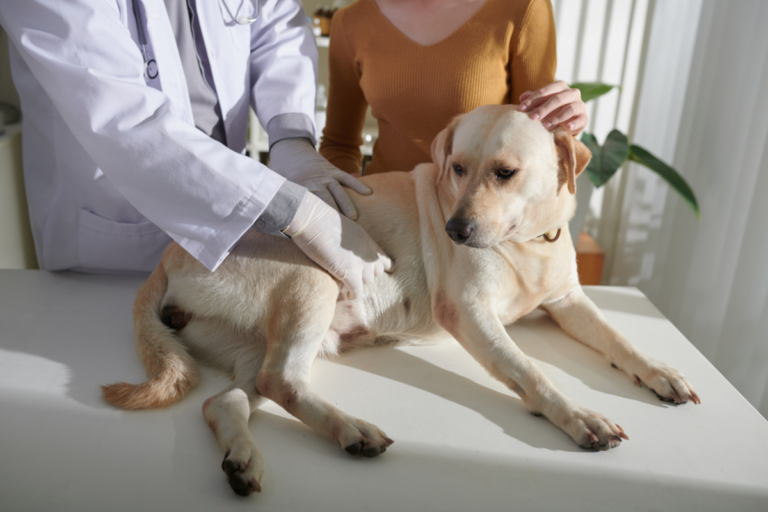Tick Talk: Understanding Symptoms of Ticks in Dogs
Tick Bite Symptoms in Dogs
Hey there fellow dog lovers! We’ve got to keep our furry pals safe from tick bites, right? Knowing what signs to watch out for can help us act fast and keep our pups both healthy and happy.
Recognizing Tick Bites
Spotting tick bites can sometimes feel like searching for a needle in a haystack. These little critters start out small—like pinheads—but can bloat up to a pencil eraser size when they’re full (Orlando Vets). They often have eight creepy-crawly legs and can hide out in your dog’s fur, easily blending in because of their stealthy color variations. When they’re snacking on your dog, ticks might give away their presence with:
- Redness and swelling at the bite site.
- Annoying skin irritation and inflammation.
- A hard, lumpy bump that can look bluish-black as the tick fills up on blood.
If we even get a whiff of suspicion about a tick bite, it’s straight to the vet for us! (Green Cross Vets).
Common Symptoms
Ticks can dish out trouble, from annoying little issues to much bigger health scare scenarios. Check out some common symptoms to keep an eye on:
| Symptom | Description |
|---|---|
| Scratching and Licking | Our pooches might go on a scratching, licking, or chewing spree. They could look like they’re trying to shake something off their head or gnawing at feet and legs. (Orlando Vets) |
| Loss of Appetite | They might turn their nose up at food or act all fussy because of discomfort. |
| Behavioral Changes | You might notice pacing, distress, or downright restlessness as they try to handle the tickly irritation. (Orlando Vets) |
| Visible Ticks | Sometimes, we might just catch those sneaky ticks hanging onto our dog’s skin, especially post-snack-time when they’re all plumped up. |
Spotting even one of these can be our cue to thoroughly inspect for any ticks and get vet help pronto. Tackling the problem early stops it from snowballing into worse issues, like pesky dog diseases and symptoms carried by ticks.
In our quest to keep tabs on tick symptoms, we’re looking out for our fur babies’ wellbeing like the champs we are. For more scoop on this and other health tidbits, sneak a peek at our pages on dogs health and black ticks on dogs.
Types of Ticks in Dogs
Ticks might be tinier than a flea’s sneeze, but don’t let that fool ya—they’re like hitchhikers with attitude! Let’s get into the nitty-gritty about three tick types that love crashing the dog gig: paralysis ticks, bush ticks, and brown dog ticks.
Paralysis Ticks
First up, paralysis ticks. They’re the stuff of nightmares for pet owners down under. These Aussie natives hang out on the east coast, chillin’ in those warm, humid spots. Their bite is more than a pinch—these bad boys inject neurotoxins that can leave your pup paralyzed and, if ignored, worse. Dogs aren’t their first love; they usually bug native critters, but when it comes to this buffet, they’re not picky.
Quick Deets on Paralysis Ticks:
- Where They Lounge: East coast of Australia
- Who They Bug: Mostly native animals
- Why They’re Troublemakers: Paralysis via neurotoxin
Bush Ticks
Next on our list are bush ticks, also known as cattle ticks. No, they’re not wrestlin’ cattle in the outback, but they do hang out on the eastern side. They’re all about that farm life but sometimes stroll over to dogs too. These pests can make your dog itchy, spread diseases, and if they really dig in, cause anemia.
Important Bush Ticks Info:
- Where They Settle: East coast of Australia
- Who They Annoy: Cattle and dogs
- What’s the Fuss: Skin irritation, disease, anemia
Brown Dog Ticks
Last but not least, enter the brown dog ticks. Unlike their more dramatic cousins, they’re not packing diseases in their luggage, but they can still cause a good scratch-fest. Predominantly into dogs, they cozy up in places like Adelaide and Melbourne, loving the mild climate life.
Need-to-Know on Brown Dog Ticks:
- Where They Hang: Central/northern Australia, uh…wherever it’s not too hot, not too cold
- Who They Love: Dogs
- What They Do: Cause skin irritation, spread infections
| Tick Type | Chill Zones | Go-to Hosts | Trouble They Bring |
|---|---|---|---|
| Paralysis Ticks | East Australia | Native buddies | Neurotoxic nastiness |
| Bush Ticks | East Australia | Cattle, dogs | Skin crawly, sick deal, possible anemia |
| Brown Dog Ticks | Central & north AUS | Dogs | Makes ’em itch, infections a-go-go |
Knowing who’s who in the tick world helps us shield our pups from unwanted cooties. Spot the signs, keep an eye out for those sneaky tick species, and you’ll be ahead in this furry battle. Check out our pages about dogs and ticks and healthiest dog breeds for the whole enchilada on keeping ticks at bay.
Risks and Concerns
Alright folks, we’re diving into the nitty-gritty of tick-related troubles for your four-legged pals. Buckle up, because knowing the risks and concerns is just as important as those extra treats and belly rubs. So, let’s jump right in:
Tick Season in Australia
So, here’s the scoop. In the Land Down Under, ticks throw a party from September through March, especially those pesky paralysis ticks—dangerous critters those are (Green Cross Vets). But don’t get too cozy once summer’s over. Ticks, like that one annoying mosquito, can pop up any time, especially if you live where it’s mild and toasty year-round. Keeping an eye on your pup for these little hitchhikers all year is the best way to keep them safe.
Tick Diseases Transmitted
Ticks are basically the carriers of some nasty stuff, and we’re not talking about their bad manners at parties. Here’s what your pooch could catch:
-
Lyme Disease: No, it’s not a cocktail. It’s carried by black-legged deer ticks, leading to joint woes, limping, tiredness, and fever. In worst-case scenarios, we’re talking kidney and heart issues, too (Westport Veterinary Associates).
-
Bartonellosis: The brown dog tick is the villain here. It brings fever, wobbly legs, brain hiccups, hunger strikes, and a heartbeat that sounds like a drum solo. Bonus—humans can catch it too, so keep it away from both you and your pooch (Orlando Vets).
-
Anaplasmosis: Think fever and joint hugs with a side of bed rest.
-
Ehrlichiosis: Similar symptoms as Lyme Disease, plus some fun extras like bleeding disorders (Orlando Vets).
Severity of Diseases
These tick-born villains can really bring the heat, making prevention and speedy treatment top priorities. Those paralysis ticks deserve a shout-out (or perhaps a shut-down) for their knack for spreading neurotoxins that can paralyze and be deadly without prompt action (Green Cross Vets).
Here’s how the bad guys stack up:
| Disease | Severity | Symptoms |
|---|---|---|
| Lyme Disease | Can be severe | Joint pain, limping, lethargy, fever, kidney failure, heart and nerve troubles |
| Bartonellosis | Moderate to Severe | Fever, limping, brain issues, seizures, hunger loss, funky heartbeat |
| Anaplasmosis | Moderate | Fever, achy joints, tiredness, appetite loss |
| Ehrlichiosis | Severe | Fever, sluggishness, puffy lymph nodes, bleeding |
Being in-the-know about what ticks can do to your pup puts you in a stronger spot to prevent and tackle these issues head-on.
Looking for more deets on tick-terrors and how to keep them at bay? We’ve got a wealth of wisdom just waiting for you. Mosey on over to our articles on tick diseases for more tips and tricks. Remember to stand guard for your wagging buddy against these intruders with a solid game plan. Swing by our resources on canine disease and dog diseases and symptoms for even more savvy advice.
Behavioral Signs
Changes in Behavior
Detecting those pesky ticks in our pooches isn’t just about spotting them hitching a ride. Our dogs, clever as they are, often drop hints in their behavior before showing any physical signs. Here’s what to keep an eye out for:
- Lack of Appetite: If your dog’s bowl’s still full at dinner time, and they’re giving it the cold shoulder, those ticks might be making them uneasy.
- Pacing and Fussing: Ever seen your dog doing laps around the living room or acting like they’ve got ants in their pants? That’s a sign they’re feeling bothered.
- Lethargy: If your usually bouncing buddy is turning into a couch potato or giving their toys the stink eye, ticks might be the culprit.
Noticing these behavior tweaks is your cue to spring into action. It’s time to schedule a vet’s appointment for a checkup and possibly a tick-ectomy.
Signs of Distress
Ticks don’t just bring a change of mood—they can make our dogs downright miserable. So, let’s decode some of their distress signals:
- Scratching and Licking: If your pup’s going to town on their skin, scratching like there’s no tomorrow or giving personal grooming a whole new meaning, it could be tick time (Orlando Vets).
- Shaking the Head: Ticks love to burrow near the head and ears. If you see your dog headbanging without the music, it’s worth checking for these tiny troublemakers.
- Chewing at Feet or Coat: Dogs love a good chew, but if they’re gnawing at their own feet or fur, it might be their way of saying: “I’ve got a tick problem, human!”
- Picking at Coat: They might also resort to picking at their coat as if trying to reveal an unsolved mystery.
| Behavioral Sign | Description |
|---|---|
| Lack of Appetite | Ignoring food, missing meals |
| Pacing | Restless, can’t sit still |
| Lethargy | Acting mellow, less playful |
| Scratching | Fierce body scratching |
| Licking | Overdoing feet, legs, or coat licks |
| Shaking Head | Continuous shaking menace |
| Chewing | Feet-fur munching action |
| Picking | Teasing their own coat |
Catching these distress calls early on can help us swoop in for a save. Preventative strategies and treatments can ease our pals’ discomfort and kick those ticks to the curb. For the low-down on how to stop ticks in their tracks, don’t miss our guide on tick removal tips and the lowdown on medications and prevention tactics.
Long-Term Effects
Alright folks, we’re diving into the world of ticks and how they can mess with your pups for the long haul. Ticks are more than just creepy crawlies; they’re little disease-carrying fiends that can give your doggo a hard time. We’re breaking down the nitty-gritty into two parts: diseases spread by ticks and the havoc they wreak on health.
Disease Transmission
These sneaky ticks are like tiny vampires—when they latch onto your dog, they can pass along a host of nasty bugs. Knowing what’s out there helps you keep your best bud out of trouble.
- Lyme Disease:
- Spread by: Black-legged ticks, aka deer ticks
- What to Look For: Limping like a peg-legged pirate, swollen joints, fever, and just overall doggy sadness
- When it Gets Ugly: Kidney problems, heart issues, and scrambled brains might occur (Westport Veterinary Associates)
- Canine Bartonellosis:
- Spread by: Brown dog tick
- What to Look For: Fever, poor coordination, seizures, no appetite, and wonky heart rhythm
- Ehrlichiosis:
- Spread by: Brown dog tick, lone star tick
- What to Look For:
- The Early Days: Fever, chunky lymph nodes, weight loss, bleeding easily, and brain fog
- Lurking Stage: Nothing you’ll notice without a lab coat and a microscope
- The Long Haul: Anemia, unexpected bleeding, eye issues, swollen arms or legs (VCA Hospitals)
A quick peek at the villains:
| Nasty Bug | Sneaky Tick | Sneaky Symptoms | Full-Blown Chaos |
|---|---|---|---|
| Lyme Disease | Deer Tick | Joint pain, pirate limp, fever, lethargy | Kidney chaos, heart, and nerve problems |
| Canine Bartonellosis | Brown Dog Tick | Fever, wobbly walk, funky heart beat | Heart rhythm that’s out of tune |
| Ehrlichiosis | Brown, Lone Star Tick | Fever, swollen nodes, light weight | Anemia, unexpected nosebleeds, eye troubles |
Health Implications
Tick-borne baddies can leave your pet dealing with some awful stuff long term. Getting a jump on them means trouble doesn’t catch up with your pooch.
- Kidney Drama:
- Often from Lyme playing the long game
- Watch for constant drinking, peeing, or straining
- Scoot on over to the lowdown on canine kidney disease symptoms
- Brain and Nerve Mayhem:
- Lyme or Ehrlichiosis can tinker with the noggin
- Signs include seizures, weird behavior, and coordination going haywire
- Peek at seizures in dogs symptoms for more scary deets
- Blood and Guts—Literally:
- Chronic Ehrlichiosis can sap the blood and cause it to ooze
- Watch for pale gums, bloody noses, or red in the toilet
- Learn more on dog diseases and symptoms
Keeping an eye on your dog for signs of these issues and getting them to a vet pronto is a must. Stay strong against ticks with the right prevention and removal tips—your dog will thank you for it. Check out our prevention guide on dogs and ticks.
By staying sharp and taking action when you need to, we’re giving our furry sidekicks every chance at a tick-free, tail-wagging life.
Prevention and Treatment
Tick Removal Methods
Keeping our pups safe from those pesky ticks is a must! Imagine spotting a hard bump on your dog’s skin, possibly signaling a tick enjoying an unwanted meal. Often, these sneaky little vampires swell up into an obvious bluish-black ball while feeding. It’s best to have these ticks professionally removed by a vet who knows the ropes.
If you’re in a bind and can’t whisk your dog off to the vet, here’s a quick DIY guide to tick removal:
- Grab Some Fine-Tipped Tweezers: Get a hold of the tick as close to the skin as you can.
- Steady Pull, No Twisting: Firmly but gently pull the tick straight up. Twisting or yanking risks leaving bits of the bugger behind.
- Clean Up: Post-removal, clean the bite spot and your hands with some rubbing alcohol, iodine scrub, or good old soap and water.
- Tick Disposal: Toss the tick in alcohol, seal it in a bag or container, wrap it up in tape, or—adios!—flush it down the loo.
Nailing the right tick removal technique helps dodge those nasty tick-borne illnesses. For the inside scoop on how ticks mess with dogs and the troubles they bring, check out our sections on seizures in dogs symptoms and dog diseases.
Medications and Preventative Measures
Stopping ticks before they get a taste is the best way to keep our fluffy friends safe from the gnarly diseases they can carry, like Lyme Disease or Ehrlichiosis. No one wants to deal with those, trust us.
Here’s a lineup of meds and preventive tricks to keep ticks at bay:
| Medication/Preventative Method | Description |
|---|---|
| Topical Treatments | Monthly potions applied between the shoulder blades to smack ticks into oblivion. |
| Oral Medications | Delicious chewables that are a monthly treat and tick warrior rolled into one. |
| Tick Collars | Neck shields offering long-lasting protection, especially around the head and neck. |
| Tick Dips | Medicated baths sponged across the body to keep ticks away. |
| Spot-On Treatments | Fast protection for up to a month with just a dash of liquid magic. |
Besides popping perfect pills, keep these in mind:
- Dodge Tick Zones: Keep your dog away from tall grasses and wild brush.
- Regular Inspections: Check over Rover for any tick stowaways after romps outside.
- Steady Grooming: A good grooming routine makes spotting ticks quick and easy.
Explore our guides on related issues like bloat symptoms dog and dog heart disease for more doggo health wisdom.
Keeping an eye out and managing ticks ensures our pups stay sprightly and content. Always get your vet’s two cents for tailored advice that suits your dog’s unique needs.






